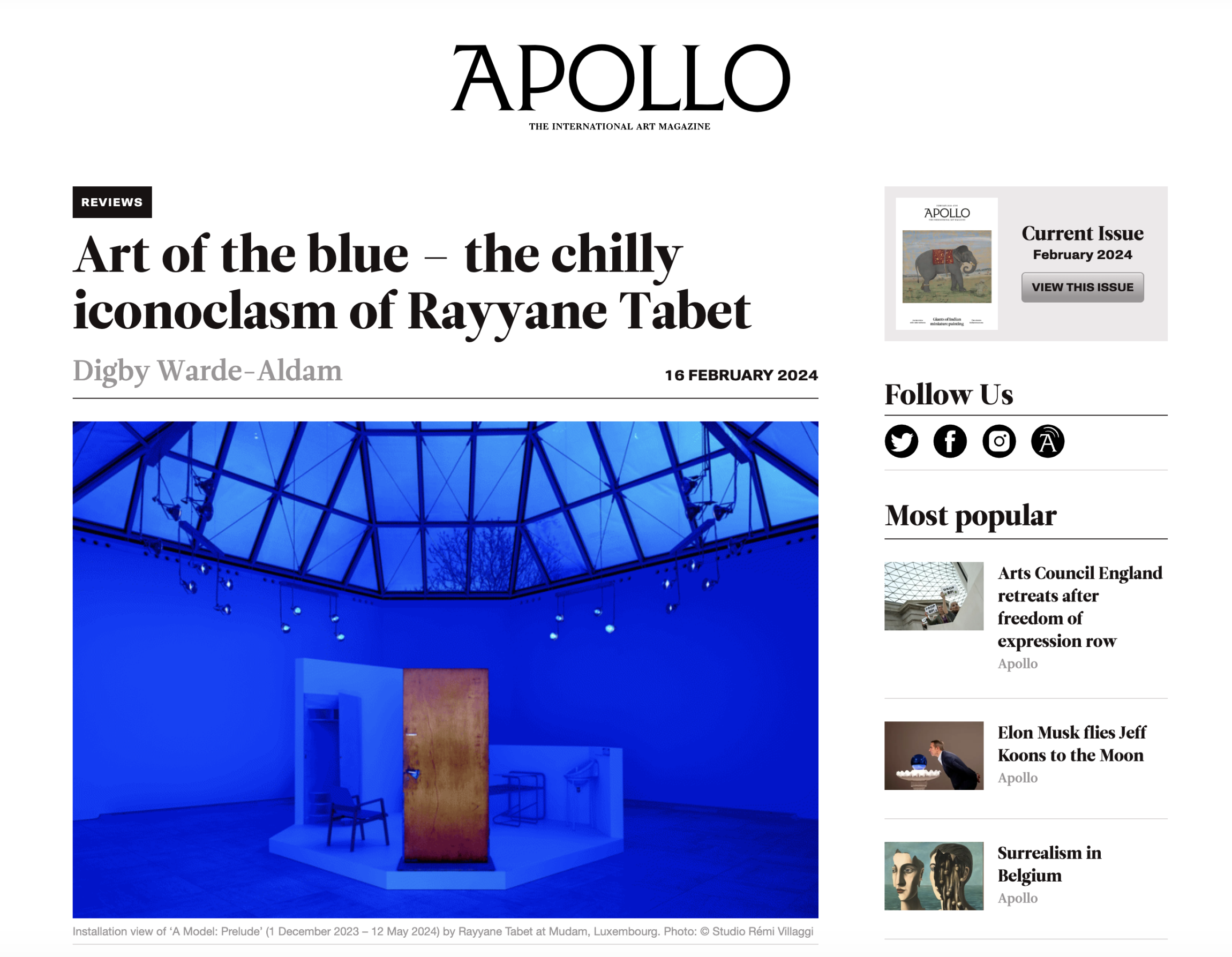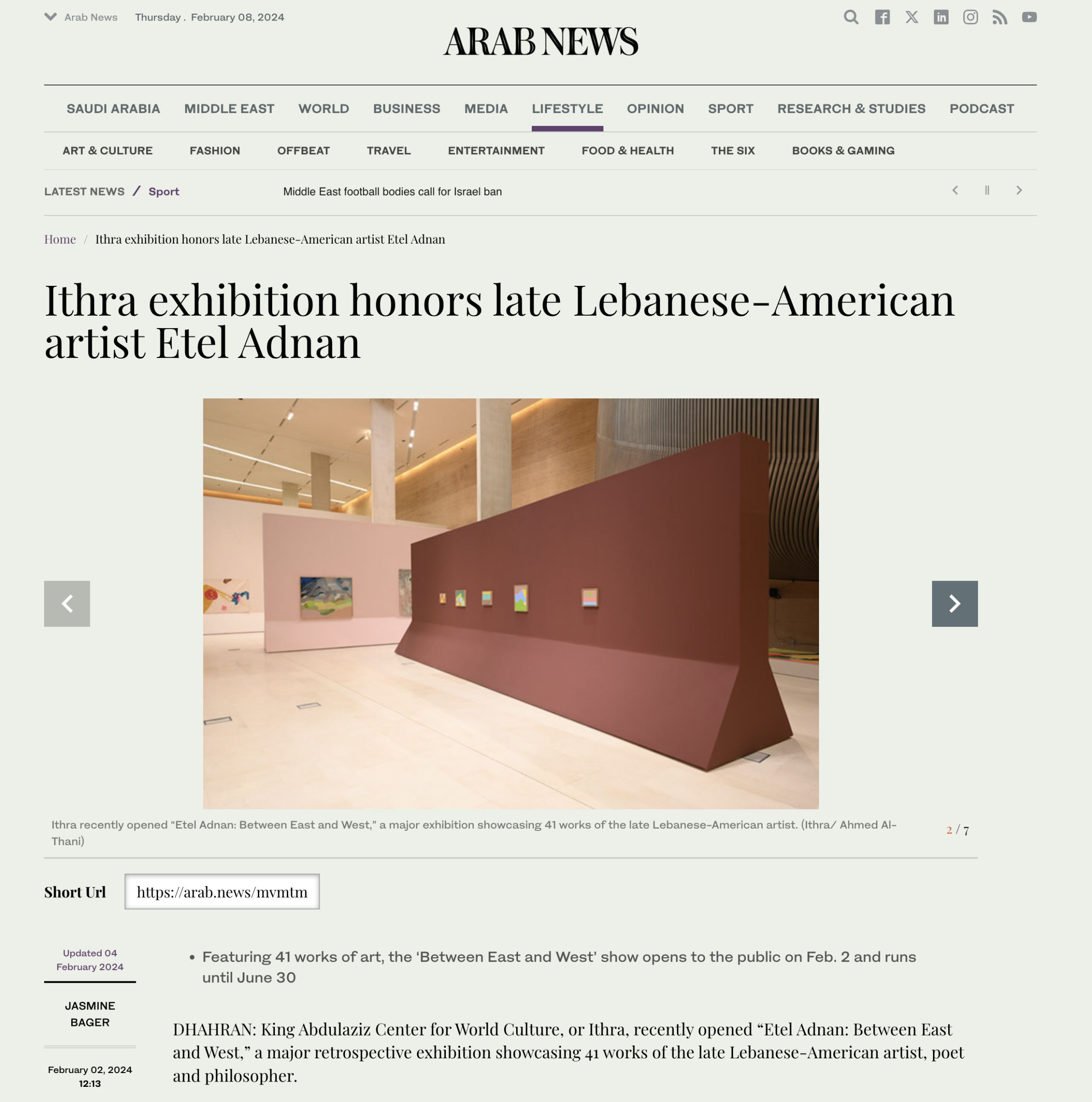Press

"As she prepares her solo show for Lebanon’s pavilion at the 60th Venice Biennale, the artist discusses some of her recent work."

"Rayyane Tabet has transformed part MUDAM into a chilly twilight zone, in which signifiers of domestic comfort become mechanisms of basic survival and the modernist utopianism of the architect’s vision is contorted into something altogether more uncertain. It is the best kind of site-specific art: a thoughtful, unsentimental meditation on the particularities of its host institution and a powerful retort to the well-meant but hubristic orthodoxy from which it sprang. Its resonances continue to ring in the ears long after you have walked through the exit."

"King Abdulaziz Center for World Culture, or Ithra, recently opened “Etel Adnan: Between East and West,” a major retrospective exhibition showcasing 41 works of the late Lebanese-American artist, poet and philosopher. Revered as one of the most renowned contemporary artists from the region — and still considered a major figure in the Arab modernism movement — the space at Ithra’s gallery is the first solo exhibition of Adnan’s work in Saudi Arabia, running until June 30."

"Mounira Al Solh is nominated for Artes Mundi 10 alongside Rushdi Anwar, Carolina Caycedo, Alia Farid, Naomi Rincón Gallardo, Taloi Havini and Nguyễn Trinh Thi. This year’s 10th anniversary prize is presented with the Bagri Foundation and will be awarded to an established international artist whose practice has ‘significantly contributed to art that resonates with our times’. An exhibition of work by the nominees is now open across five venue partners in Wales, with the seven artists presenting major solo projects that ‘collectively address issues surrounding land use, territory and displacement through histories of environmental change, conflict and enforced migration, conditions that speak to us all today’."

"Khalil Rabah has taken his traveling 20-year exhibition to Europe to share the plight of Palestinians."

"The work in Wael Shawky’s "I Am Hymns of the New Temples" boasts Greco-Roman tales, Pompeiian and Nile locations, and not-quite-human characters."

"Trente-huit ans après l’ouverture de sa galerie en Allemagne, dix-huit ans après son installation dans le quartier de la Quarantaine à Beyrouth, Andrée Sfeir-Semler vient d’inaugurer un second espace, dans le centre-ville de Beyrouth, à la faveur de l’exposition « Arabesque » de Rayyane Tabet qui explore les thèmes de l'héritage, l'appropriation culturelle et la subjectivité de la perception."

"That achievement of complexity or sophistication from humble means is one that echoes through the history of embroidery. For Kettle’s Yard’s current exhibition in Cambridge, Material Power: Palestinian Embroidery (until October 29), the curator and art historian Rachel Dedman has united examples of the highly decorated dresses through which Palestinian women traditionally identified themselves. Through their needlework, the women are fighting against the obliteration of memory, history and a sense of place, embodied in localised traditions of embroidery. Alongside historic pieces are artworks by contemporary artists such as Mona Hatoum, Khalil Rabah, Mounira Al Solh, Aya Haidar, Majd Abdel-Hamid and Maeve Brennan which honour the craft’s potent legacy."
"At the outset of the Syrian Revolution in 2011, Lebanese artist Rabih Mroué began engaging with cell phone videos shot by civilians that were proliferating on YouTube and Facebook. With the rise of social media, these videos circulated to an international audience, disrupting the heavily regulated images produced by the Syrian regime. The Pixelated Revolution reflects Mroué’s attempt to apprehend the images shot by protestors, for whom producing a record was a final act preceding their murders by the regime."

"À la faveur de son installation immersive « The Return »*,Rayyane Tabet déploie avec la magie qui est la sienne un voyage, à mi-chemin entre enquête policière et paysage émotionnel, rapiéçant l’histoire d’une tête de taureau exhumée lors des fouilles du temple d’Echmoun à Saïda en juillet 1967 avant de réapparaître en 2017, dans les galeries gréco-romaines du Metropolitan Museum of Art à New York..."

"Rayyane Tabet discusses ‘The Return,’ his current show at Sfeir-Semler gallery, and how objects mean."

“Akram Zaatari was born in Saida, Lebanon in 1966. While growing up, armed conflict and a perpetual crisis loomed over everyday life. At a young age he began documenting life in Saida under Israeli occupation, taking photographs and collecting documents and objects specific to the culture and political landscape of the time. Zaatari revisited some of these documents, oral histories and photographs in the installation ‘Letter to a Refusing Pilot’, while representing Lebanon at the 55th Venice Biennial in 2013.”

“Artistic interest in paranoia, conspiracy, and governmental secrecy is hardly new. Yet Tieu’s work is representative of a particular strain of recent art demanding further elaboration. By this I mean work that is first and foremost research-based, frequently comprising ready-made elements incorporated into larger installation-cum-environments and often, but not always, mobilizing video, sound, and other screen infrastructures. … This work is like many of these categories, but it is not properly any of them. It shimmers with similitude but parries true equivalence.”

“Much of Batniji’s practice encapsulates this need to capture immateriality and the residues of loss. At the entrance of ‘No Condition Is Permanent’, his survey show at Mathaf in Doha, sits Impossible Journey (2002–09), an installation the artist created by laboriously shovelling sand from one spot to another – a performance captured in an accompanying looped video. Shown alongside ID Project (1993–2020), which documents the arduous process the stateless Palestinian artist undertook to obtain residency in France, the work frames the sense of dispossession – from land and nationality – that comprises the Palestinian condition.”

« The pioneering painter and digital artist explains what makes the computer the ultimate tool of abstraction. »